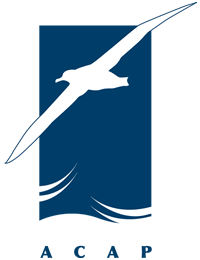-
Repeating last year’s achievement – the first translocated Black-footed Albatross chick on Oahu fledges on World Albatross Day
Ready to fledge: a translocated Black-footed Albatross rests betweem two adult decoys; photograph by Leilani Fowlke, Pacific Rim Conservation The first Black-footed Albatross Phoebastria nigripes (Near Threatened) of the current cohort of translocated...
-
Mexico fledges ‘Snowflake’, its first ever Black-footed Albatross, in time for World Albatross Day
Post No. 6 for ‘WADWEEK2021’ In the air and ready to fledge with its metal and colour bands: a translocated Black-footed Albatross on Isla Guadalupe - with a guano-splattered decoy watching on The first globally Near Threatened Black-footed Albatross...
-
Black-foots from USA to Mexico: first international albatross translocation is underway
A long-term conservation project: “Reintroduction of Black-footed Albatrosses (Phoebastria nigripes) from Midway Atoll National Refuge, USA to Guadalupe Island Biosphere Reserve, Mexico” has been initiated by the United States Fish & Wildlife Service...
-
ACAP Breeding Sites
Introduction In February 2013, ACAP Latest News commenced posting a series of brief accounts describing breeding sites of ACAP-listed species. In considering what constitutes a breeding site, differences in conservation management procedures have been...
-
Presentations on ACAP-listed species at the Pacific Seabird Group’s 45th Annual Meeting in Mexico this week
The Pacific Seabird Group’s 45th Annual Meeting will be held at the at Universidad Autónoma de Baja California Sur in La Paz, Mexico over 21-24 February 2018. Presentations on ACAP-listed species are listed below as extracted from the meeting’s...
-
A Future for Seabirds: the Pacific Seabird Group meets next week to hear about North Pacific albatrosses (and other procellariiforms)
The Pacific Seabird Group will be holding its 42nd Annual Meeting next week in San Jose, California, USA, with the theme “A Future for Seabirds”. According to the meeting’s abstract book 10 presentations will be given on the three species of...
-
ACAP Breeding Site No. 62. San Benedicto Island, Mexico, has a small, growing population of Laysan Albatrosses
Isla San Benedicto is located 370 km south of the tip of Baja California and is one of three main islands in the Mexican Islas Revillagigedos Archipelago. The Reserva de la Biosfera Archipiélago de Revillagigedo (established in 1994) was designated as...
-
ACAP Breeding Site No. 61. Rocas Alijos, Mexico support a tiny, recently-established population of Laysan Albatrosses
Rocas Alijos (Alijos Rocks) are located 320 km west of Baja California, Mexico. They consist of three volcanic rocky spires: North (29 m high), Middle (18 m) and South (35 m) Rocks along with numerous smaller low-lying rocks that are often awash. Rocas...
-
Pollutants in North Pacific albatrosses from the Hawaiian USA and Mexico
Suhash Harwani, Department of Toxic Substances Control, California Environmental Protection Agency, Berkeley, California, USA and colleagues writing on-line in the journal Environmental Toxicology and Chemistry have looked at pollutant levels in two...
-
Important Bird Areas in the Americas support ACAP-listed albatrosses and giant petrels
A directory of Important Bird Areas in the Americas has been published by BirdLife International. A total of 2450 IBAs has been identified in 57 countries or territories within the region. Six of the countries/territories covered in the publication...
© 2024 ACAP. All rights reserved. Privacy Policy Manage Your Data LoginLogout

 English
English  Français
Français  Español
Español